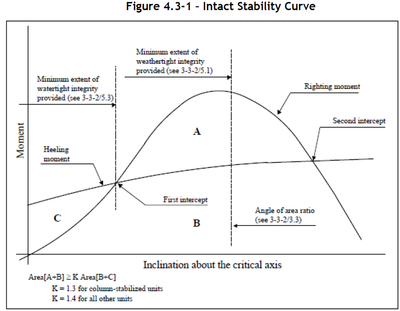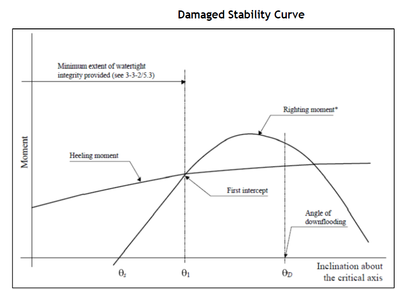MOPU TRANSIT STABILITY ANALYSIS
The aim of this article is to establish the intact and damaged stability properties of the Mobile Offshore Production Unit (MOPU).
The study shall be divided into two stages:
For towing operation,towing rules stipulates some minimum trim by aft. Like noble dention recommends a minimum trim of 0.5% of Ls. So transit stability shall include trim of vessel.
MOPU’s intact and damaged stability in the transit condition are accessed with the legs fully retracted (the spudcans are located in the legwell).
The purpose of this study shall be to verify and provide additional information on the intact and damage stability of the unit during the towing operation from site to dry dock using lightship and Centre of Gravity (CoG).
Detailed stability analysis will provide
The study shall be divided into two stages:
- Identifying the minimum achievable transit draught for intact and damaged stability analyses and code checking
For towing operation,towing rules stipulates some minimum trim by aft. Like noble dention recommends a minimum trim of 0.5% of Ls. So transit stability shall include trim of vessel.
MOPU’s intact and damaged stability in the transit condition are accessed with the legs fully retracted (the spudcans are located in the legwell).
The purpose of this study shall be to verify and provide additional information on the intact and damage stability of the unit during the towing operation from site to dry dock using lightship and Centre of Gravity (CoG).
Detailed stability analysis will provide
- A detailed load case (containing lightship weight and ballast information)
- A corresponding draught (to be subsequently used in the motions analysis)
- A limiting VCG for each load case, according to class requirements
METHODOLOGY OF MOPU INTACT & DAMAGE STABILITY CALCULATION
Establish the maximum draught achievable by the MOPU
- Ensuring that the unit complies with the intact and damage stability criteria,together with estimating the maximum allowable KG
MOPU INTACT & DAMAGE STABILITY CRITERIA
Class recommends a wind speed of 36m/s (70knots) for normal operating and transit conditions, while for severe storm conditions, a wind speed of 51.5m/s (100knots) and 25.8m/s (50knots) should be applied for intact and damaged cases respectively.
- For self-elevating units, the area under the righting moment curve at or before the angle of the second intercept of the righting and the heeling moment curves or the downflooding angle, whichever is less, is to reach a value of not less than 40% in excess of the area under the heeling moment curve to the same limiting angle.
- The righting moment curve is to be positive over the entire range of angles from upright to the second intercept angle.
The criteria for damage stability
- The final waterline, after assuming damage with a heeling moment equivalent to a 25.8m/s (50kn) wind superimposed from any direction, is not to exceed the levels to which watertight integrity.
- Self-elevating units are to have sufficient residual stability to satisfy the following criterion, after assuming the single compartment flooding and with the assumption of no wind:
Range of Stability (RoS) ≥ 7° + 1.5 θs
where θs is the static angle of inclination after damage, in degrees. The range of stability is determined without reference to the angle of downflooding.
MOPU MODELLING & TRIM FOR STABILITY
The hydrostatic model incorporates the spud cans and steel work from the legs into the main hulls. Furthermore, to account for the loss of buoyancy, the leg wells can be modeled as equivalent cylinders.
The total weight of the unit, excluding ballast (floating lightweight), as per the Weight Control Report shall be taken.
The weight and CoG values for ‘Variable Load’ and ‘Water in Spud Cans’ shall be taken from latest Weight Control Report.
The targeted towing vessel condition for the stability analysis shall be by required trim by the stern,If this condition is not achievable by lightship,water ballast shall be used for required trim.
USE OF WATERTIGHT/WEATHERTIGHT INTEGRITY IN STABILITY
Non-watertight openings can be either weathertight or non-weathertight. The positions of both weathertight and non-weathertight openings have a significant impact on the unit’s stability capabilities in damaged conditions. Therefore, all
these openings should be considered giving due regard to stability and extent of watertight integrity.Non-watertight openings represent downflooding points, i.e. locations that if submerged due to large heel or trim will let the sea water enter the vessel in an uncontrolled manner. For non-watertight openings, a positive freeboard after damage in wind is therefore required.
For the MOPU, the weathertight downflooding points on the main deck are the air vents of the ballast tanks with a standard height of 760mm above deck.
If tank vents are located towards the portside and starboard outboard extremities of the transverse barge, will have potential to become immersed when the vessel heels to the equilibrium angle after damage, in wind.
STABILITY ANALYSIS RESULTS
The stability analyses results for the intact and damaged conditions (single compartment damage) for various drafts shall be prepared.Applicable guidelines for towing operations recommend an initial angle of trim. An assessment of the MOPU stability in the case of an initial trim angle shall be performed
In intact conditions, the vessel must comply with the area ratio requirements (AR>1.4). The area ratio calculations have been done for the range of heeling angles between the first and second intercepts, as shown below:
The damage stability shall be performed for same draft range.
STABILITY CONDITION TO ACHIEVE TRIM
The Noble Denton guidelines for Marine Transportations recommend an initial minimum trim of 0.5deg by the stern for towed vessels. To achieve the actual weight and ballast distribution of the MOPU, if required additional water ballast shall be loaded on the vessel, draft of the vessel will increase compared to loading condition without ballast. Sometimes due to this increased draft, the weathertight downflooding points (ballast tanks air vents) on the main deck immerse when the equilibrium angle after damage in wind velocity 25.8m/s is achieved. This will lead to failure of class requirement. In this scenario, the air vents on the main deck shall be made watertight for the entire duration of the voyage.


